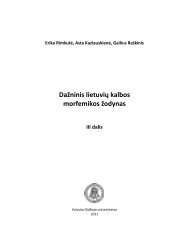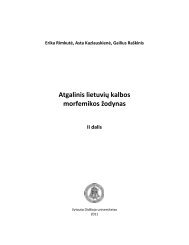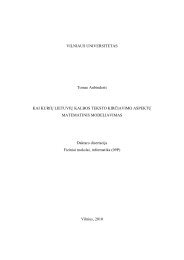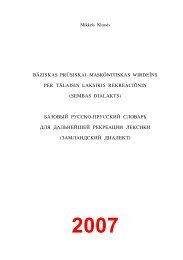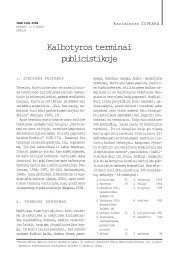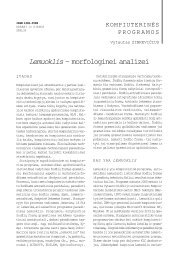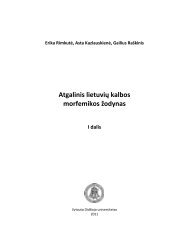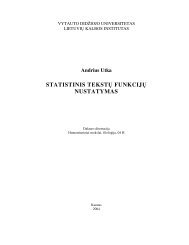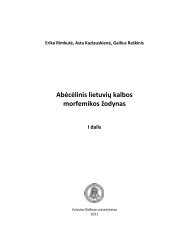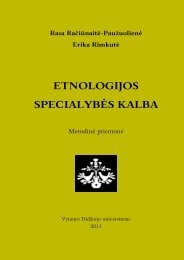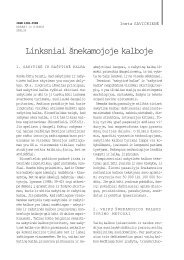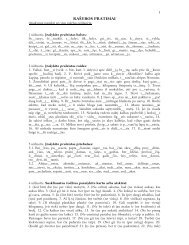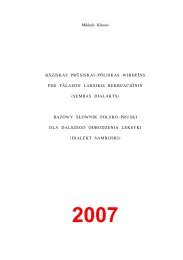HISTORICAL GRAMMAR OF OLD PRUSSIAN
HISTORICAL GRAMMAR OF OLD PRUSSIAN
HISTORICAL GRAMMAR OF OLD PRUSSIAN
Create successful ePaper yourself
Turn your PDF publications into a flip-book with our unique Google optimized e-Paper software.
<strong>HISTORICAL</strong> <strong>GRAMMAR</strong> <strong>OF</strong> <strong>OLD</strong> <strong>PRUSSIAN</strong><br />
sponding infinitive stems: gerdaus ‘tell!’ (: if. gerda[u]t ‘to tell’), dînkauti<br />
‘thank!’ (: if. dînkaut ‘to thank’), cf. Stang Vergl. Gr. 440.<br />
b) permissive<br />
* 242. Prussian permissive possesses only one inflection -sei (14x)<br />
of the 3rd person, spelled -se (9x), -sai (3x), -si (2x), e.g.: seisei, boûse<br />
‘let ... be!’, audasei ‘let (it) happen!’, dase ‘let (him) give!’, galbse ‘let<br />
(him) help!’, pareysey ‘let ... come!’ tussîse ‘let (her) be silent!’, wirse ‘let<br />
become!’, pokûnsi ‘let (him) protect!’. It seems that the origin of Prussian<br />
permissive 3 pers. -sei is conncted with an optative -s- form of the future<br />
tense, cf. Stang Vergl. Gr. 442 f., Endzelîns SV 122 f. with bibl. 117<br />
* 243. Above discussed permissive forms in -sei are used mostly in<br />
main clauses. As for subordinate clauses, one finds there more often forms<br />
in -lai in the 3rd Catechism. Their meaning is close to subjunctive mood,<br />
e.g.: kaden ... (ni) boûlai III 113 23–27 ‘when ... would (not) be’, ickai ainonts<br />
... turîlai III 99 11 ‘if anybody ... had’, quai niturrîlai III 103 12 ‘which should<br />
not have’, madlimai ... kai stas ... perçilai III 49 18 ‘we pray ... that it ...<br />
come’, Tou quoitîlaisi III 79 14–15 ‘Thou wouldst wish’, enkasmu mes ...<br />
turrîlimai boût III 113 21–23 (with -limai < *-laimai) ‘in what we ... should<br />
be’, quoitîlaiti III 67 14–15 ‘ye would wish’, etc.<br />
* 244. An attempt to derive Prussian formant -lai, together with<br />
Lith. prtc. l³µ, Latv. prtc. la±, from v. *laid-/ *leid- ‘to let’ (e.g. Fraenkel<br />
329 with bibl., cf. Endzelîns SV 124 with bibl.) was strictly criticized by<br />
Bûga I 452 ff. He showed on rich Baltic material that all these formants<br />
come from particle *l- extended with various vocal and diphthong elements<br />
(cf. Endzelîns l. c., Stang Vergl. Gr. 443). This opinion of K. Bûga<br />
has been supported and proved by Toporov PJ IV 418–436 (with bibl.).<br />
117 Cf. also: “kann ... angenommen werden, daß sich auch im Westbaltischen kein sigmatisches<br />
Futur entwickelt hatte und daß die prußischen Formen der 3. Person auf -sei als ein “embrionäres,<br />
nichtparadigmatisches “Futur” aufzufassen sind [Palmaitis 1981, vgl. Iwanow 1981, 195 f.],<br />
d.i. hier liegt ein “futuraler” (oder “resultativer”) Optativ vor” (Palmaitis L. Optativ und Personalendungen<br />
im Prußischen / Baltistica XXI (2) 160); Palmaitis 1981: Îò ãðå÷åñêîé ñèñòåìû ê<br />
ñëàâÿíñêîé / Âîïðîñû ÿçûêîçíàíèÿ, No 4; Iwanow 1981: Ñëàâÿíñêèé, áàëòèéñêèé è ðàííåáàëêàíñêèé<br />
ãëàãîë. Ìîñêâà: Íàóêà. More detailed: Palmaitis BGR 239–241. – L.P.<br />
99



